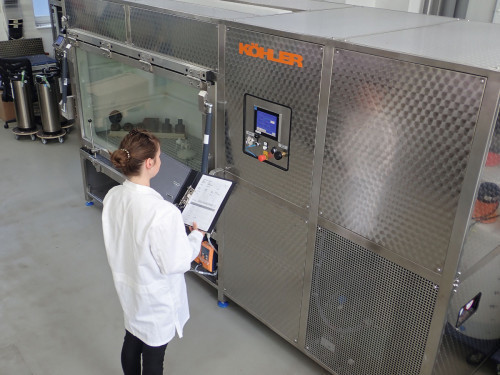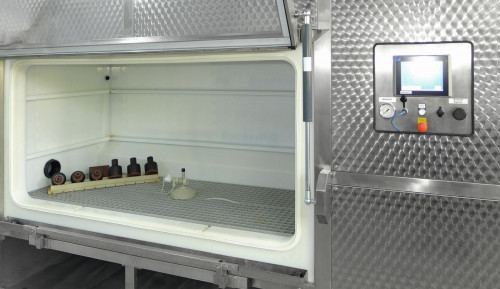The Institute for Electroplating and Surface Technology Solingen (IGOS) uses simulations of weather conditions to carry out material tests for the automotive industry, among others, in order to prevent corrosion-related failures. IGOS is now repositioning itself with modern testing technology - ensuring even greater reliability and depth of testing.
One difficulty is that the various corrosion and weathering tests are often carried out one after the other in different test chambers, which means that the components have to be relocated at great expense. However, such interruptions can have a negative impact on the test results. At the Institute for Electroplating and Surface Technology Solingen (IGOS), this is now a thing of the past:
Testing without repositioning
With a new corrosion test chamber, corrosion and environmental simulations can now be carried out fully automatically in the same chamber without moving the test parts. The size of the system (chamber size: 2m3) and the flexible control system enable even more consistent simulation of natural corrosion processes. IGOS is an accredited test laboratory that is officially approved by Mercedes-Benz for initial material testing in accordance with WEB 2020+ and is listed as an approved laboratory in the V100 list.
In the worst-case scenario, corrosion-related component failures can paralyze the service brakes or other safety-related functions (in the vehicle). This is why manufacturers are repeatedly confronted with recalls due to potential defects. This is why appropriate material testing during development and vehicle construction is so important. "The testing framework is defined by a large number of standards and regulations, which are, however, subject to change. Like the components themselves, they also undergo development, which the testing laboratories have to face up to in good time," explains Dipl.-Ing. Josef Andrek, Managing Director of the Institut für Galvano- und Oberflächentechnik Solingen GmbH & Co KG (IGOS).
A few years ago, for example, the VDA corrosion change test VDA 233-102 became mandatory, which specifies the assessment of components using a time-accelerated test procedure. Salt spray phases are cyclically combined with other climatic conditions. In many laboratories, this series of tests is carried out in different chambers, which requires the components to be repositioned manually. At IGOS, too, the components previously had to be moved between the climate chamber and a salt spray chamber three times a week for three hours. Such manual interventions in the test phase and the inevitable change in the test position can lead to falsification of the results under certain circumstances.
Multifunctional test chamber
 Fig. 1: IGOS has recently expanded its testing equipment with a new universal test chamber that enables the complete corrosion testing process to be carried out on one machine
Fig. 1: IGOS has recently expanded its testing equipment with a new universal test chamber that enables the complete corrosion testing process to be carried out on one machineTo avoid this, IGOS has recently expanded its testing equipment with a new combination test chamber (Fig. 1), which enables the complete corrosion testing process to be carried out on one machine. At the same time, more capacity is now available in the other chambers, which would otherwise have been occupied for one testing process. The automated system enables the creation of reproducible corrosion images. These visualize the weak points in coatings or the corresponding vulnerability of the material without having to realign the test object during the test cycles.
With this new test chamber, a combination of salt spray, humidity, temperature and freezing phases is possible. The device is operated completely automatically. By simulating the individual cycles alternately, the test object is exposed to a change in weather that corresponds to the real conditions in later operation, which allows the subsequent corrosion behavior to be represented more precisely. After this test, the quality of the coating can be assessed more efficiently and accurately through additional evaluations of artificial injuries such as scratch, cross-cut, scratch or stone chip tests. To begin with, the component only needs to be positioned once and the desired test program selected. Once the chamber door is closed, the system carries out all cycles independently. "Manual interventions that could falsify the results are no longer necessary, so we can guarantee significantly higher process reliability and analysis accuracy," says Andrek. The corresponding supply of process water and temperature is provided by high-quality heating and cooling circuits, which in turn are connected to a brine tank and various compressed air connections. Thanks to an installed climate module, tests in the temperature range from -15 to +60 °C are possible. "This functional extension is particularly necessary for corrosion change tests in accordance with VDA 233-102, as a cold phase at -15 °C is run through here," adds Andrek.
To avoid this, IGOS recently expanded its test equipment with a new combination test chamber (Fig. 1), which enables the complete corrosion test process to be carried out in one machine. At the same time, more capacity is now available in the other chambers, which would otherwise have been occupied for one testing process. The automated system enables the creation of reproducible corrosion images. These visualize the weak points in coatings or the corresponding vulnerability of the material without having to realign the test object during the test cycles.
With this new test chamber, a combination of salt spray, humidity, temperature and freezing phases is possible. The device is operated completely automatically. By simulating the individual cycles alternately, the test object is exposed to a change in weather that corresponds to the real conditions in later operation, which allows the subsequent corrosion behavior to be represented more precisely. After this test, the quality of the coating can be assessed more efficiently and accurately through additional evaluations of artificial injuries such as scratch, cross-cut, scratch or stone chip tests. To begin with, the component only needs to be positioned once and the desired test program selected. Once the chamber door is closed, the system carries out all cycles independently. "Manual interventions that could falsify the results are no longer necessary, so we can guarantee significantly higher process reliability and analysis accuracy," says Andrek. The corresponding supply of process water and temperature is provided by high-quality heating and cooling circuits, which in turn are connected to a brine tank and various compressed air connections. Thanks to an installed climate module, tests in the temperature range from -15 to +60 °C are possible. "This functional extension is particularly necessary for corrosion change tests in accordance with VDA 233-102, as a cold phase at -15 °C is run through here," adds Andrek.
 Fig. 2: The interior of the chamber is equipped with a special weather-resistant plastic and has a large volume so that test objects of different sizes and even complete assemblies can be subjected to the tests
Fig. 2: The interior of the chamber is equipped with a special weather-resistant plastic and has a large volume so that test objects of different sizes and even complete assemblies can be subjected to the tests
The interior of the chamber is lined with a special weather-resistant plastic (Fig. 2) and has a larger volume of 2m3 (WD: 2 x 1 x 1 m), so that test objects of different sizes and even complete assemblies can be subjected to the tests. Flexibility was also a priority for the control system: Various test programs are stored in the control cabinet, which can be operated via a practical touch panel. The chamber has an integrated computer on which a program for operating the test chambers has been loaded. This program can be used to program new tests or modify existing ones. In addition, new tests pre-programmed by the manufacturer can be downloaded from the memory. During a test, all values are automatically recorded and saved so that they can later be easily transferred to a corresponding analysis protocol and archived. A practical test log ensures the traceability of each individual test cycle.
IGOS has a comprehensive pool of devices
The new test chamber is the latest addition to the comprehensive equipment pool that the institute uses in its daily work. Thanks to the multifunctional chamber, other equipment is less frequently tied up for corrosion tests and can be used for other corrosion simulations at the same time. In addition to corrosion tests, IGOS also carries out supplementary chemical material and coating analyses as well as various types of tests in the field of electroplating and painting technology. Prominent customers of the accredited laboratory include Mercedes-Benz "With the new test chamber, we believe we are now even better equipped for the various challenges and test scenarios that we encounter in vehicle construction and other areas," summarizes Andrek.
By simulating the individual phases alternately, the test object is exposed to a change in weather that resembles the real conditions in later operation. This makes it possible to predict possible corrosion behavior
Photos: IGOS


